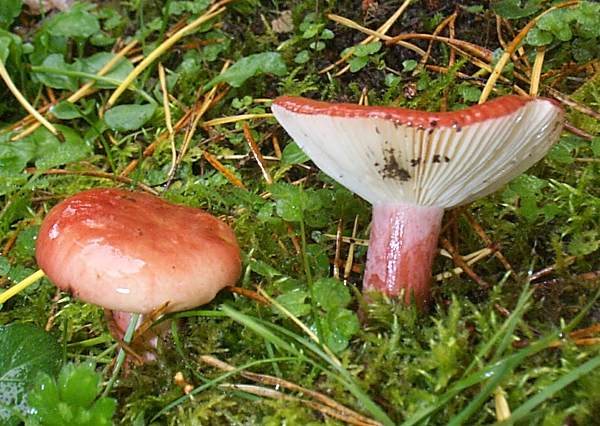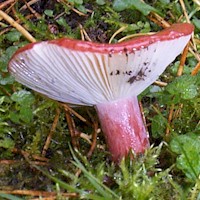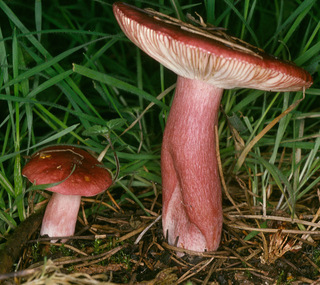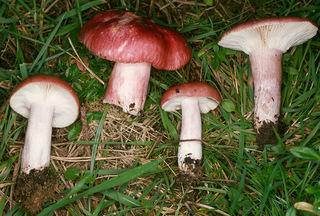Russula sanguinaria
Blood Russula ( Russula sanguinaria )
The blood Russula ( Russula sanguinaria, syn. R. sanguinea ), also known as Blood Red Russula, is a species of fungus in the family Täublingsverwandten. The fungus, which can be found from July to October, especially among pine trees, not one of the edible mushrooms.
- 5.1 Infra Generic Systematics
- 7.1 Literature
- 7.2 Notes and references
Features
Macroscopic characteristics
The Blood Täubling has a blood-red, tomato-red or rarely bright red hat, but they can fade out strongly with age. The surface is dull and wrinkled. The skin is hardly differentiated and can not be removed. The hat measures 4-10 inches in diameter. The flesh is whitish and bitter and spicy at the same time.
The slats are beginning to pale, then discolour after straw yellow color and buttery with age. Unlike many other Täublingsarten they are more or less decurrent.
The stem is whitish to pink and from two to seven inches long. It has a diameter from 0.8 to 3 inches. The spore powder is pale yellow.
Microscopic characteristics
The spores are elliptical and 7-10 microns long and 6-8 microns wide. The majority of isolated warts are standing up to 1.0 microns high. Sometimes a few connecting lines are formed between the warts. Some warts can be partially extended. The basidia are cylindrical to clavate, measuring 33-50 x 10-11 microns, and each bear four sterigmata.
The 50-70 microns long and 8-12 microns wide cheilocystidia are spindle -shaped and appendikuliert majority at their peak. The slightly larger pleurocystidia look similar and are 65-130 microns long and 11-16 microns wide. All Zystiden are numerous and stain clear gray black in sulfobenzaldehyde to.
The hat skin consists of cylindrical, slightly tapered at the top or widened 3-4.5 microns wide hair-like hyphae, which are mostly simple septate. Their more or less gelatinized hyphal. Are cylindrical to spindle- shaped or club-shaped Pileozystiden weak, which can also be partially constricted at its peak between the hyphae. They are 4-7 microns wide, not or rarely septate. In sulfobenzaldehyde they turn to gray black and react as strongly with Sulfovanillin.
Artabgrenzung
- The Cherry Red Russula Russula emetica memory also grows under conifers. He has a bright red hat and nearly always a white stalk. Even the slats and the spore powder are white.
- The rather rare weak spot Russula Russula end persicina also has a bright red hat, his stick is usually white, the hat skin can be removed entirely, he also turns yellow very strongly to pressure points. His fins are also ripe cream- ocher.
- The very rare in Germany Sumpftäubling Russula helodes looks almost the same. But he preferred bog - pine forests dotted with peat moss Sphagnum.
Ecology
The Blood Täubling like all russulas a mycorrhizal fungus, which can form a symbiotic relationship with various conifers. He clearly preferred the pine forest as a symbiotic partner. Only very rarely he goes with spruce or other conifers into a symbiotic relationship.
You can find the Täubling in winter forest green pine forests, steppes, Salbeigamander - oak and white moss pine forests as well as in sparse pine and spruce forests or parks. Under interspersed pines it is also eaten in beech and fir mixed forests, clearings, juniper heaths and semi-dry grasslands and sometimes in raised bog edges.
The fungus usually preferred dry, acidic to neutral, moderately to well-supplied with nutrients soils, such rankers, Regosolen, braunlehm - Rendzinen and Luvisols. It is rare on peat soils.
The fruiting bodies appear between July and November. The Täubling comes from the lowlands ago to the middle mountains.
Dissemination
The Blood Täubling is a Holarctic type, that is, he comes almost found all over the northern hemisphere. You can find the Täubling in Northern Asia ( the Caucasus, Russia and the Far East, Korea and Japan ), North America (USA), in the Canary Islands, North Africa (Morocco, Tunisia) and Europe. In Europe it is distributed from the meridional to the boreal zone with moderately cool climate.
In northern Germany the species is quite rare, south of the 51st degree of latitude it comes at least before regional frequently.
System
The species was first described in 1803 by Heinrich Christian Friedrich Schumacher as Agaricus sanguinarius and recognized in 1989 by Stephan Rauschert as Russula sanguinea. Bulliard described the same way regardless as Agaricus sanguinea, which was then provided by Elias Magnus Fries in the genus Russula. The Artepiphet sanguinea (Latin sanguis = blood ) is derived from its blood-red color.
Infra Generic Systematics
Blood Red Russula is the type kind of sub-section Sanguinae (after Bon ), a sub- section of section Firmae. This subsection combines pungent russulas with red to purple colored hats and cream to ocher-colored spore powder.
Importance
The Blood Täubling is edible, not one in Germany but to the edible mushrooms. The Food and Agriculture Organization ( FAO) lists the style yet as edible mushroom, which is consumed mainly in Thailand, Hong Kong and Ukraine.









